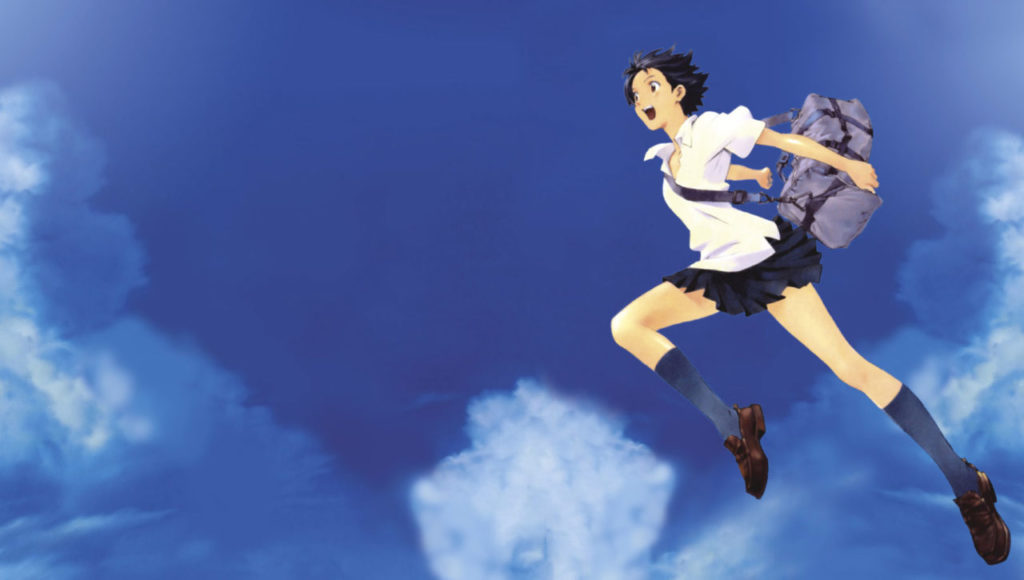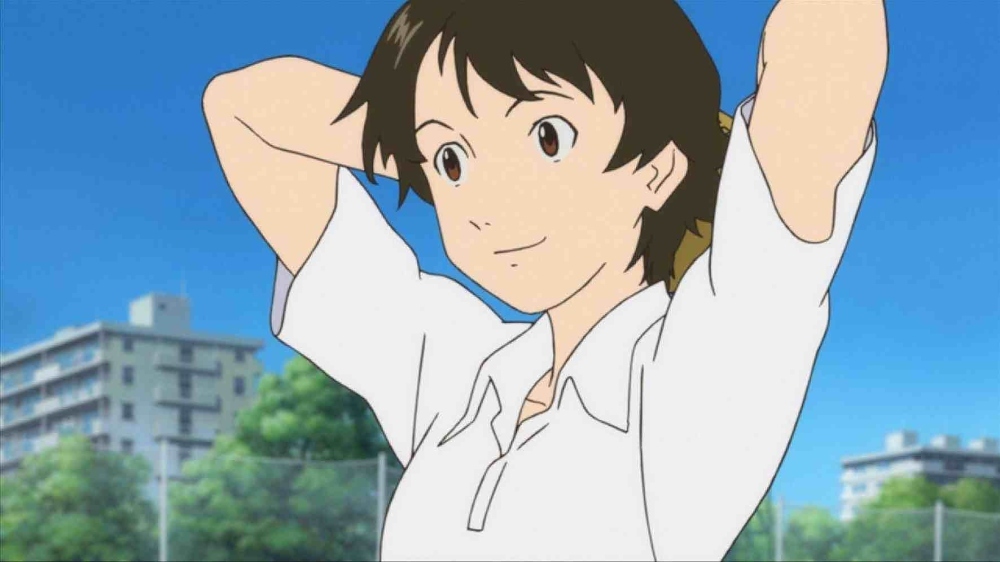Girls Who Leapt Through Time
December 23, 2022 · 0 comments
By Andrew Osmond.

Readers of this blog will know The Girl Who Leapt Through Time as the seminal breakthrough film by Mamoru Hosoda, the future director of Belle and Mirai. But if you search on on Amazon, you’ll notice there are other versions of the story, including a recently-added live-action film by director Nobuhiko Obayashi. His decades-spanning filmography ranges from the cult horror-comedy House (not to be confused with the American cult horror-comedy House) to his extraordinary final epic, Labyrinth of Cinema (imagine Millennium Actress for three hours). Another of Obayashi’s last films, Hanagatami, is reviewed in-depth on this blog by Jasper Sharp.

Obayashi’s version of Girl Who Leapt is now available two ways. If you just want to see the film, you can rent or buy it to stream from Amazon Prime here. For more serious fans of the director, it’s available as one of four films on Third Windows’ new Blu-ray set, Nobuhiko Obayashi’s 80s Kadokawa Years, which bundles in Okamoto’s archival interview on the film.
First, though, there’s the matter of the history of Girl Who Leapt. It didn’t originate as a film but as a prose story, published in a couple of magazines for schoolkids in the 1960s. You can read it in English, as there’s an official translation. It was an early piece by the author Yasutaka Tsutsui, who would later gain a considerable literary reputation for adult fiction. Hosoda’s anime of Girl who Leapt… was made by Madhouse around the same time that the studio was also animating a different Tsutsui story – Paprika, directed by Satoshi Kon, where Tsutsui voices a virtual barman.

His Girl who Leapt… story is very short, and you may notice the girl in the story has a different name from the anime, not Makoto but Kazuko. She’s nearing the end of Junior High, and has two male friends (just friend friends) called Goro and the daydreaming Kazuo. One day, Kazuko is cleaning the school science lab when she sees a shadowy stranger, who hastily exits. The girl finds a spilled chemical concoction, and the aroma of lavender, which briefly knocks her out. When her concerned friends revive her, everything seems normal… but weirdness is about to commence.
A few days later, Kazuko and Goro are hurrying to school when a truck runs out of control and bears down on them. Then Kazuko suddenly finds herself in bed, having seemingly dreamed the whole thing. She gets to school (no mishaps) and settles into class… to find she’s doing the same lesson as yesterday, only yesterday is happening today! Kazuko has somehow slipped in time, getting more and more freaked as events play out as she remembers. Of course, she has no problem avoiding the truck. (Another author would have arranged a less avoidable catastrophe; an asteroid collusion, perhaps.) But Kazuko must find out what’s happening to her…
Despite Tsutsui’s gentle prose, one of the most striking things in the story is Kazuko’s extreme disorientation, as reality seemingly turns into a dream – or, worse, a dream “reality” from which she can’t wake. Satoshi Kon fans will know this feeling from Perfect Blue; Kon in turn was a fan of Tsutsui. The story also has a possible homage to Marcel Proust in the notion of time-travel being linked to a nostalgic sense-impression, like Tsutsui’s lavender or Proust’s memory-inducing madeleine cakes (also referenced in Serial Experiments Lain).
Kazuko is presented as a bright, inquisitive girl, good at taking authority over her classmates (at the start, Goro complains she bosses him around). At the same time, she’s given to following the directions of other people, even when the consequences are very painful for her. Another time traveller describes her as a “such a peaceful girl,” which would sound weird for a protagonist in a Western children’s story. Even in the conservative Famous Five books, the main girl is the tomboy George.
Kazuko’s adventure was retold on screen for successive generations, often with plot embellishments. Time Traveller, a six-part television version in 1972 (featuring Junko Shimada as Kazuko) invents a bereaved mother, who goes back to the 1940s to try to save her dead daughter. A five-part sequel serial followed the same year, Zoku Time Traveller, also with Shimada.

The next version followed in 1983, and this is the film by Nobuhiko Obayashi. Again, it has embellishments, although it keeps many of the details from Tsutsui’s story. The heroine is now played by Tomoyo Harada, a rising teen idol of the time, who’s still working now. While her photogenic qualities are obvious, there isn’t much sign of her acting talents, though she carries off heartbreak quite well at the end.
Whereas Hosoda’s anime would be set in a bustling Tokyo, Obayashi places the story in an attractive country town, the kind of place to give you a feeling of nostalgia no matter you grew up. The effects are dated, often risibly, but some sequences are interesting. Harada’s “leaps” are sometimes shown through sequences of photos that move you jerkily “through” locations. It’s a kind of crude stop-motion animation, sometimes deployed in the films of Jan Svankmajer. Another brief effects sequence, involving superimposed crashing waves and tunnel effects from old Doctor Who, might have influenced the far more artistic cosmic “leap” sequences in Hosoda’s anime.
The film keeps the sense of Perfect Blue-ish disorientation as Hosoda’s life goes awry. In this version, Kazuko doesn’t have to contend with a truck, but it’s suggested a time leap saves her from something more harrowing, a stalker and likely rapist. There’s also a disturbing plot strand involving a memory that Kazuko has cherished from childhood, one that turns out to have been manipulated by one of her peers so he could infiltrate her life. In another film, this could have been horrific, but Obayashi suggests it’s nothing serious.

Stylistically, the film is distinguished by its opening and closing minutes. It starts in monochrome and a 4:3 ratio, showing a ski trip whose significance isn’t explained till the end. A couple of minutes in, colour begins to illuminate the characters – the kind of effect that would be writ large in the 1998 fantasy Pleasantville. Obayashi, though, plainly had another film in mind. In Kazuko’s room, there’s a prominent poster for the classic musical of Wizard of Oz, a film that starts in black-and-white Kansas before taking the audience to a Technicolor fairyland.
None of this saves Obayashi’s film as entertainment. It’s terribly slow, and the actors aren’t nearly interesting enough, with poor Harada saddled with an especially wooden love interest. But the final scene had me jumping from my seat, because it’s very close to the most famous ending in anime cinema.

(SPOILERS follow.) The scene has no equivalent in either the source story or in Hosoda’s anime. It’s an epilogue, set several years after the main events. Kazuko has lost many of her memories – specifically those involving the boy she once loved, who had his memory removed in turn. In the last scene, the protagonists meet again by accident. But will they recognize each other?
Yes, it’s an extremely close match for the last minutes of Makoto Shinkai’s Your Name, even without trains or stairways. And that’s very interesting. Just before Obayashi made his version of Girl Who Leapt, he made another teenage film called Tenkosei (1982). It’s about… a boy and girl student who suddenly start swapping bodies (trailer). Indeed, the bodyswapping boy is played by the actor Toshinori Omi, who plays Kazuko’s friend Goro in Girl Who Leapt.
And yet, the similar ends of Your Name and Obayashi’s Girl Who Leapt could still be just coincidence. Shinkai himself acknowledges a different inspiration, a very short prose story by Haruki Murakami called “On Seeing the 100% Perfect Girl One Beautiful April Morning.” That also has the image of a boy and a girl, their memories lost, facing each other once more, with everything hinging on one last chance to remember they were in love.
Reportedly, the Murakami story was published in a magazine in 1981, so it predates Obayashi’s film by two years. In theory Obayashi might have been influenced by the Murakami story himself – there’s no similar ending in Tsutsui’s Girl Who Leapt. Either way, it’s amazing to see Your Name’s last moments anticipated so closely in another Japanese teen fantasy film more than thirty years earlier.
Obayashi’s film was followed by other versions of Girl Who Leapt. There was a TV special in 1985 with Yoko Minamino; a five-part TV serial with Yuki Uchida in 1994; a film in 1997 with Nana Nakamoto; and a TV special in 2002 featuring the girl band Morning Musume. The next version was Hosoda’s anime in 2006, except Hosoda’s film is implicitly a sequel to Tsutsui’s story. Hosoda’s time-leaping girl is far more mouthy and outgoing than Tsutsui’s one… but she’s a different generation from Kazuko, as the script points out.

In Hosoda’s film, the heroine Makoto is Kazuko’s niece, with Kazuko herself turning up as an elegant, wise and subtly mischievous spinster, working in a museum and called “Aunt Witch” by the heroine as an affectionate nickname. Many of the events in the original story are reworked – for example, the fatal accident now involves a train instead of a truck. The new girl, though, reacts to them very differently from her predecessor, making the film a comment on how our own expectations have changed.
Makoto was voiced in Japanese by the actress Riisa Naka. Four years later, she appeared in another film sequel to Tsutsui’s story. It wasn’t an anime, but the live-action 2010 film, Time Traveller: The Girl who Leapt Through Time, directed by Masaaki Taniguchi, and available on second-hand DVD. This time, Naka played Kazuko’s daughter, brash and sassy like her anime cousin (though the films are best thought of as happening in alternate universes).
The live-action plot extends Tsutsui’s tale, with characters including an adult version of Kazuko’s friend Goro. Like the anime, the story is as much a comment on how times have changed since the first Girl who Leapt. The present-day girl slips to a past decade (the 1970s) to learn how her parents’ generation lived and give them a taste of the future. It’s a reversal of Tsutsui’s story, though the 1970s was the future when the story was written. The film stands up better than Obayashi’s version, with a very un-Hollywood downbeat denouement that lingers in memory, like the smell of lavender.
Andrew Osmond is the author of 100 Animated Feature Films.
Leave a Reply